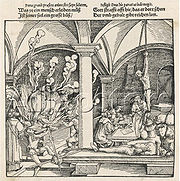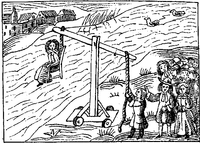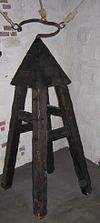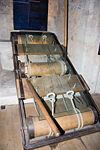- List of methods of torture
-
A list of torture methods and devices includes:
Contents
- 1 Psychological torture methods
- 2 Physical torture methods
- 3 Instruments of torture
- 4 Medieval instruments of torture
- 5 See also
- 6 References
Psychological torture methods
- Blackmailing
- Shaming and public humiliation, being stripped or displayed naked, public condemnation
- Shunning
- Exploitation of phobias; e.g., mock execution, leaving arachnophobes in a room full of spiders
- Being subjected to interrogation for long periods
- Sleep deprivation
- Solitary confinement
- Sensory deprivation
- Exposure to unpleasant sounds over a long period of time (like a large group of children suddenly screaming at the top of their lungs.)
- Threat of permanent, severe disfigurement.
- Pharmacological torture
- Threatening to hurt or kill the victim's loved ones.
- Using hypnosis to implant malicious post-hypnotic suggestions.
Physical torture methods
- Abacination
- Beatings and physical violence
- Blinding with light
- Boiling
- Bone breaking
- Branding
- Castration
- Chinese water torture
- Choking/Strangling
- Crushing
- Cutting
- Denailing
- Disfigurement
- Drowning
- Dunking
- Flagellation
- Flaying
- Foot roasting
- Foot whipping
- Force-feeding
- Garrotting
- Genital mutilation/forced circumcision
- Glasgow smile
- Hamstringing
- Kneecapping
- Keelhauling
- Mutilation
- Oxygen deprivation
- Picquet
- Pitchcapping
- Pressure points
- Rat torture
- Riding the Rail
- Sexual assault
- Sawing
- Scalping
- Scaphism
- Sleep deprivation
- Sound (extremely high volumes, dynamic range, low frequency, high pitched noise, intended to interfere with rest, cognition and concentration).
- Starvation
- Strappado/squassation (also known as "reverse hanging" and "Palestinian hanging")
- Stress positions
- Ta'liq hanging from a metal bar.
- Tarring and feathering
- Tickle torture
- Tooth extraction
- Water cure
- Waterboarding
Instruments of torture
Note that the line between "torture method" and "torture device" is often blurred, particularly when a specifically named implement is but one component of a method. Also, many devices that can be used for torture have mainstream uses, completely unrelated to torture.
- Heretic's fork
- Instep borer
- Iron chair
- Iron Maiden
- Jiá gùn
- Judas Chair
- Kia quen
- Malay boot
- Mancuerda
- Parrilla
- Pau de Arara
- Pendulum (torture device)
- Picana
- Pillory
- Rack
- Scavenger's daughter
- Scold's bridle
- Stocks
- Tablillas
- Tasers
- Tean zu
- Thumbscrew
- Tongue shredder
- Tramp chair
- Tucker telephone
- Zánzhǐ
Medieval instruments of torture
Medieval torture devices were devices used in the Middle Ages to cause pain, injury, and sometimes death, usually to extract information or a confession from criminals or prisoners, also as punishment for crimes.
Judas cradle
Main article: Judas cradleOrigins
The Judas Cradle is falsely attributed to the Spanish Inquisition. These origins are disputed by all serious historians of the Inquisition.[by whom?] There is no documented evidence for the device existing at all during the Middle Ages.
Appearance
The Judas cradle was a tall stool shaped device with a metal or wooden pyramid on top.
Use
The victim would be stripped, bound with ropes, and suspended above the device. They would then be lowered, usually very slowly, on to the device, making the pyramid enter the vagina, anus or scrotum. The amount of pain the device inflicted could be changed in several ways. The victim could be rocked, they could be dropped repeatedly onto the device, one leg could be lifted, olive oil could be spread on the pyramid, or brass weights could be hung from the victims legs.
Sometimes to prolong torture the victim would be suspended above the device overnight, and torture would continue the next morning.
The device was rarely, if ever, cleaned. If victims did not die from the device, they almost always died from infection. Torture with the Judas Cradle could last several hours to several days.
Apart from the agonizing pain one suffered, the humiliation was the primary attraction for this method of torture. Whenever the victim fainted from the pain, the torturer would lift the victim until the tortured person was "awake" again to commence with the process.
Other names
The Judas Cradle was used in several countries, each having their own names for it. In Italy it was known as "culla di Giuda", in Germany "Judaswiege", and in France "la veille".[1] It is also known as the Judas Chair.
Chair of Torture
See also: Iron chairOrigins
Used during the Middle Ages, it was used until the late 1980s in Europe.[citation needed]
Appearance
There are many variants of the chair, though they all have one thing in common: spikes cover the back, arm-rests, seat, leg-rests, and foot-rests. The number of spikes in one of these chairs ranges from 500 to 1,500.
Use
To avoid movement, the victim's wrists were tied to the chair or, in one version, two bars pushed the arms against arm-rests for the spikes to penetrate the flesh even further. In some versions, there were holes under the chair's bottom where the torturer placed coal to cause severe burns while the victim still remained conscious. In other versions there were weights that would be placed on the victims thighs or feet. In a special version there were spikes on the head rest and the executioner pushed his head against it.
This instrument's strength lies primarily in the psychological fear caused on the victims. It was a common practice to extract a confession by forcing the victim to watch someone else be tortured with this instrument.
The time of death greatly varied ranging from a few hours to a day or more. No spikes penetrated any vital organ and the wounds were closed by the spikes themselves which delayed blood loss greatly.
The Rack
Main article: Rack (torture)Origins
Medieval Britain during the time The Plantagenet kings ruled England during (1154–1485).
Appearance
The rack is a torture device that consists of an oblong, rectangular, usually wooden frame, slightly raised from the ground, with a roller at one, or both, ends, having at one end a fixed bar to which the legs were fastened, and at the other a movable bar to which the hands were tied. The victim's feet are fastened to one roller, and the wrists are chained to the other.
Use
The torturer turned the handle causing the ropes to pull the victim's arms. Eventually, the victim's bones were dislocated with a loud crack, caused by snapping cartilage, ligaments or bones. If the torturer kept turning the handles the limbs would eventually be torn off.
This method was mostly used to extract confessions, not confessing meant that the torturer could stretch more. Sometimes, torturers forced their victim to watch other people be tortured with this device to implant psychological fear.
Many knights from the Knights Templar were tortured with the rack. The limbs collected from this and other punishments of the time were "emptied by the hundreds".
Sometime this method was limited to dislocating a few bones, but the torturer often went too far and rendered the legs or arms (sometimes both) useless. In the late Middle Ages, some new variants of this instrument appeared. They often had spikes that penetrated the victim's back - as the limbs were pulled apart, so was his or her spinal cord increasing not only in physical pain, but the psychological one of being handicapped at best, too.
Brazen Bull
Main article: Brazen bull A brazen bull as depicted by Hans Burgkmair the Elder.
A brazen bull as depicted by Hans Burgkmair the Elder.
Origins
The Brazen Bull was invented in Ancient Greece, by Perillos of Athens. Perillos proposed his idea of a more painful means of execution to Phalaris, the tyrant of Akraga. Phalaris liked the idea of the Brazen Bull, and so it was made. Once finished, Phalaris ordered it to be tested on Perillos himself. Perillos was removed from the Bull before he died, but was later killed by Phalaris when he threw Perillos off a hill.[citation needed]
Appearance
The Bull was made wholly of brass, and was hollow with a door in the side.
Use
When a victim was placed inside the brazen bull, he or she was slowly burned to death. The device gradually became more sophisticated, until the Greeks invented a complex system of tubes in order to make the victim's screams sound more like an infuriated bull, and also made it so the smoke from it rose in clouds of incense.
Even though this torture was not used as frequently during the Middle Ages as it was used earlier by the Greek and Romans, it was still used in Central Europe. This torture is similar to being boiled alive.
Chinese Iron Maiden
Origin
Similar to the Iron Maiden of the 19th century, this device was first used in the Ming Dynasty.
Appearance
It stood like a coffin but was raised on a platform with an iron grate on the bottom instead of a piece of wood. Like the Iron Maiden, this coffin was made of brass or sometimes even iron. But, unlike the iron maiden, it was optional to include spikes or not.
Use
The Chinese Iron Maiden was generally used to punish those who were not loyal to the king but it was also used to set an example for other future wrongdoers. The prisoner would be locked into the coffin and made to stand on the grated bottom. Then, the executioner would pour water onto hot coals that they placed under the grated platform. The mixture of hot coals and cold water would create a cloud of steam that went into the coffin, steaming the person alive.
Pear of Anguish
Main article: Choke pear (torture)Appearance
A pear shaped instrument, consisting of four leaves that slowly separated from each other as the torturer turned the screw at the top.
Use
This device was used during the Middle Ages as a way to torture women who conducted a miscarriage, liars, blasphemers, and homosexuals.
A pear-shaped instrument was inserted into one of the victim's orifices: the vagina for women, the anus for those considered to be male homosexuals, and the mouth for liars and blasphemers.
The instrument consisted of four leaves that slowly separated from each other as the torturer turned the screw at the top. It was the torturers decision to simply tear the skin or expand the "pear" to its maximum and mutilate the victim.
The Pear of Anguish was usually very adorned to differentiate between the anal, vaginal and oral pears. They also varied in size accordingly.
This torture very rarely caused death, but was often followed by other torture methods.
Further mentions of the device appear in the 19th century. They are also mentioned in Grose's Dictionary of the Vulgar Tongue (1811) as "Choak Pears," and described as being "formerly used in Holland."[3]
They were also discussed in a book by Eldridge and Watts, superintendent of police and chief inspector of the detective bureau in Boston, Massachusetts (1897). While accepting that ordinary pear-shaped gags exist, they observed that contemporary robbers used no such device as Palioly's Pear and cast doubt upon its very existence in the first place, saying that "fortunately for us this 'diabolical invention' appears to be one of the lost arts, if, indeed, it ever existed outside of de Calvi's head. There is no doubt, however, of the fashioning of a pear-shaped gag which has been largely used in former days by robbers in Europe, and may still be employed to some extent. This is also known as the 'choke-pear', though it is far less marvellous and dangerous than the pear of Palioly."
Dunking
Main article: Dunking Punishing a common scold in the dunking stool.
Punishing a common scold in the dunking stool.
Use
This was a form of punishment that was mainly reserved for supposed witches. The victim was tied to a chair which was elevated by ropes above a pond or vat of water. The victim was then lowered into the water until completely submerged. The chair was raised if the victim was about to pass out, or to give the victim a chance to confess. If the victim confessed they would most likely be killed. This method was widely used during the Spanish Inquisition and in England and France. Other uses include the Salem Witch Trials in New England, where supposed witches were subjected to varying lengths of time and levels of submergence. The victim was usually intermittently submerged for many hours until he or she revealed information or death had occurred.
While supposed witches were commonly tortured using this method, thieves and murderers could be subjected to it in order to extract a confession. This was more common when other more sophisticated torture devices were not present.
Dunking was also used as punishment for common scolds.
Boiling
Main article: Death by boilingUse
A large Cauldron was filled with water, oil, tar, tallow or molten lead. The liquid was then boiled. Sometimes the victim would be placed in the cauldron before it was boiled so as to be cooked slowly. Or they would be placed, usually head first, into the already boiling liquid.
This was more frequently a way to execute a prisoner rather than to extract a confession.
Exposure
Types
Freezing
In the winter, the naked victim was forced to stand outside in full view of everyone. Slowly, the torturer poured water on his head which eventually became frozen making the victim die slowly and painfully. Sometimes the body was left for the whole winter to terrify the population and dissuade any further crimes.
Burning
In the summer, the person would be coated with a mixture of boiling water and oil while stripped naked, and put out in the sun. Then they would burn them to death.
Live Burial
Further information: Premature burialAs its name implies, this method consists of exposing a victim to the elements. The victim could be buried up to his neck letting any animals, insects or other people kill him slowly.
Restraint
In some towns there were chains, stocks or ropes used to quickly restrain someone outside. In very severe cases, the victim was simply left to die of hunger and thirst.
In addition to regular restraint, the gibbet, a large basket made of iron or other metal, with holes large enough for arms and legs, but not for an entire body to fit through, would be hung from a pole with a person inside it. During hot days, the metal would heat, causing pain. During cold days and nights, the chill, as well as lack of protection from the wind, could easily sap a victim's body heat. The holes in the grating were also big enough to allow carrion birds, and the occasional rat, to enter and pluck at a victim's skin and eyes.
Use
Due to its cost efficiency and cruelty, the exposure torture was very widespread in medieval Europe. The victim's remains often served as a warning to the population.
In many cases, the victim was sentenced to a short period of exposure, depending on the crime. However, death was frequent since they were completely defenseless.
Brown Rats
Main article: Rat tortureA cheap and effective way to torture someone was with the use of rats. There were many variants, but the most common was to force a rat through a victim's body (usually the intestines) as a way to escape. This was done as follows:
- The victim was completely restrained and tied to the ground or any horizontal surface.
- The victim would then have many slits cut in their stomach.
- Then they would place starving rats in the slits and would eat the victim from the inside.
Gnawing in the intestines usually took a few hours of agonizing pain for the victim. This almost always resulted in death.
See also
- Mediaeval Torture Museum in Rüdesheim am Rhein (Mittelalterliches Foltermuseum)
- Torture Museums
References
- ^ de la Sierra, Joaquin. "Judas Cradle (Torture)". Medieval Times & Castles. http://www.medievality.com/judas-craddle.html.
Categories:- Instruments of torture
- Physical torture techniques
- Psychological torture techniques
- Society-related lists
- Physical punishments
Wikimedia Foundation. 2010.


